boot SKODA OCTAVIA 2012 3.G / (5E) User Guide
[x] Cancel search | Manufacturer: SKODA, Model Year: 2012, Model line: OCTAVIA, Model: SKODA OCTAVIA 2012 3.G / (5E)Pages: 222, PDF Size: 13.52 MB
Page 51 of 222
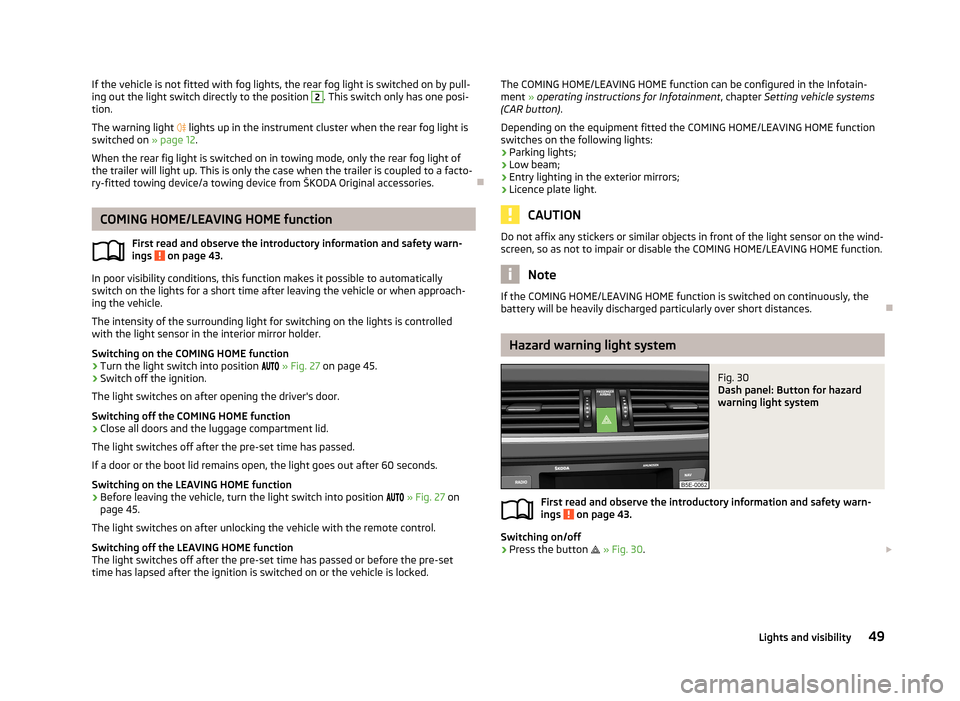
If the vehicle is not fitted with fog lights, the rear fog light is switched on by pull-
ing out the light switch directly to the position 2. This switch only has one posi-
tion.
The warning light ïȘ lights up in the instrument cluster when the rear fog light is
switched on » page 12.
When the rear fig light is switched on in towing mode, only the rear fog light of the trailer will light up. This is only the case when the trailer is coupled to a facto-
ry-fitted towing device/a towing device from Ć KODA Original accessories.
ï
COMING HOME/LEAVING HOME function
First read and observe the introductory information and safety warn-ings
on page 43.
In poor visibility conditions, this function makes it possible to automatically
switch on the lights for a short time after leaving the vehicle or when approach-
ing the vehicle.
The intensity of the surrounding light for switching on the lights is controlled
with the light sensor in the interior mirror holder.
Switching on the COMING HOME function
âș
Turn the light switch into position ïïïï
» Fig. 27 on page 45.
âș
Switch off the ignition.
The light switches on after opening the driver's door.
Switching off the COMING HOME function
âș
Close all doors and the luggage compartment lid.
The light switches off after the pre-set time has passed.
If a door or the boot lid remains open, the light goes out after 60 seconds.
Switching on the LEAVING HOME function
âș
Before leaving the vehicle, turn the light switch into position ïïïï
» Fig. 27 on
page 45.
The light switches on after unlocking the vehicle with the remote control.
Switching off the LEAVING HOME function
The light switches off after the pre-set time has passed or before the pre-set
time has lapsed after the ignition is switched on or the vehicle is locked.
ï€The COMING HOME/LEAVING HOME function can be configured in the Infotain-
ment » operating instructions for Infotainment , chapter Setting vehicle systems
(CAR button) .
Depending on the equipment fitted the COMING HOME/LEAVING HOME function switches on the following lights:
âș Parking lights;
âș Low beam;
âș Entry lighting in the exterior mirrors;
âș Licence plate light.
CAUTION
Do not affix any stickers or similar objects in front of the light sensor on the wind-
screen, so as not to impair or disable the COMING HOME/LEAVING HOME function.
Note
If the COMING HOME/LEAVING HOME function is switched on continuously, the
battery will be heavily discharged particularly over short distances.ï
Hazard warning light system
Fig. 30
Dash panel: Button for hazard
warning light system
First read and observe the introductory information and safety warn-
ings on page 43.
Switching on/off
âș
Press the button ïŸ
» Fig. 30 . ïŁ
ï€49Lights and visibility
Page 56 of 222
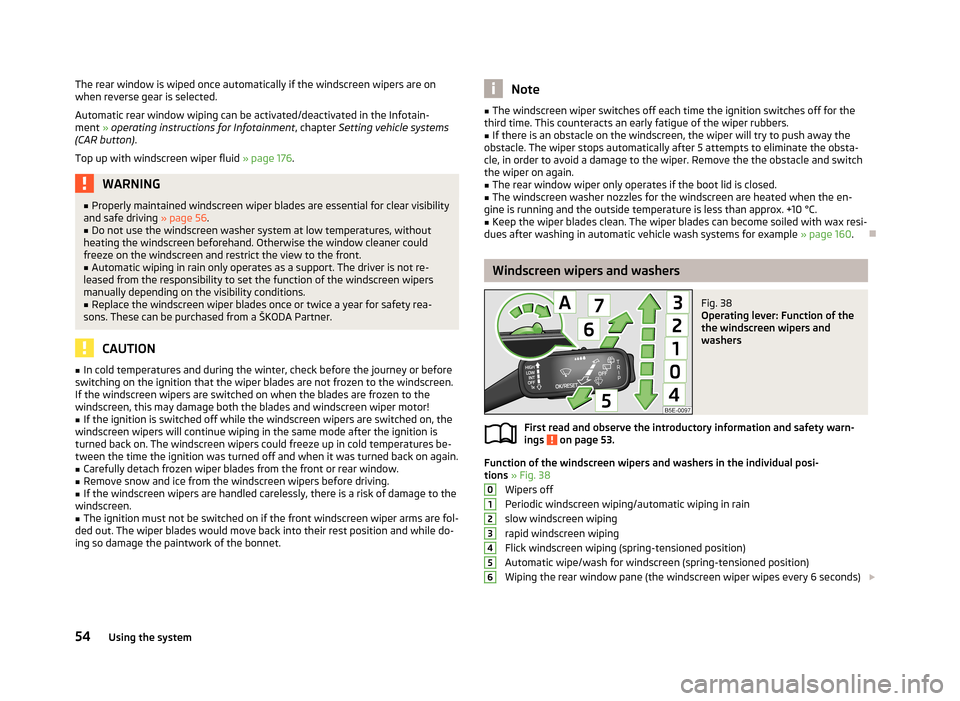
The rear window is wiped once automatically if the windscreen wipers are onwhen reverse gear is selected.
Automatic rear window wiping can be activated/deactivated in the Infotain-
ment » operating instructions for Infotainment , chapter Setting vehicle systems
(CAR button) .
Top up with windscreen wiper fluid » page 176.WARNINGâ
Properly maintained windscreen wiper blades are essential for clear visibility
and safe driving » page 56.â
Do not use the windscreen washer system at low temperatures, without
heating the windscreen beforehand. Otherwise the window cleaner could
freeze on the windscreen and restrict the view to the front.
â
Automatic wiping in rain only operates as a support. The driver is not re-
leased from the responsibility to set the function of the windscreen wipers
manually depending on the visibility conditions.
â
Replace the windscreen wiper blades once or twice a year for safety rea-
sons. These can be purchased from a Ć KODA Partner.
CAUTION
â In cold temperatures and during the winter, check before the journey or before
switching on the ignition that the wiper blades are not frozen to the windscreen. If the windscreen wipers are switched on when the blades are frozen to the
windscreen, this may damage both the blades and windscreen wiper motor!â
If the ignition is switched off while the windscreen wipers are switched on, the
windscreen wipers will continue wiping in the same mode after the ignition is
turned back on. The windscreen wipers could freeze up in cold temperatures be- tween the time the ignition was turned off and when it was turned back on again.
â
Carefully detach frozen wiper blades from the front or rear window.
â
Remove snow and ice from the windscreen wipers before driving.
â
If the windscreen wipers are handled carelessly, there is a risk of damage to the
windscreen.
â
The ignition must not be switched on if the front windscreen wiper arms are fol-
ded out. The wiper blades would move back into their rest position and while do-
ing so damage the paintwork of the bonnet.
Noteâ The windscreen wiper switches off each time the ignition switches off for the
third time. This counteracts an early fatigue of the wiper rubbers.â
If there is an obstacle on the windscreen, the wiper will try to push away the
obstacle. The wiper stops automatically after 5 attempts to eliminate the obsta-
cle, in order to avoid a damage to the wiper. Remove the the obstacle and switch
the wiper on again.
â
The rear window wiper only operates if the boot lid is closed.
â
The windscreen washer nozzles for the windscreen are heated when the en-
gine is running and the outside temperature is less than approx. +10 °C.
â
Keep the wiper blades clean. The wiper blades can become soiled with wax resi-
dues after washing in automatic vehicle wash systems for example » page 160.
ï
Windscreen wipers and washers
Fig. 38
Operating lever: Function of the
the windscreen wipers and
washers
First read and observe the introductory information and safety warn-
ings on page 53.
Function of the windscreen wipers and washers in the individual posi-
tions » Fig. 38
Wipers off
Periodic windscreen wiping/automatic wiping in rain slow windscreen wipingrapid windscreen wiping
Flick windscreen wiping (spring-tensioned position)
Automatic wipe/wash for windscreen (spring-tensioned position) Wiping the rear window pane (the windscreen wiper wipes every 6 seconds) ïŁ
ï€012345654Using the system
Page 59 of 222
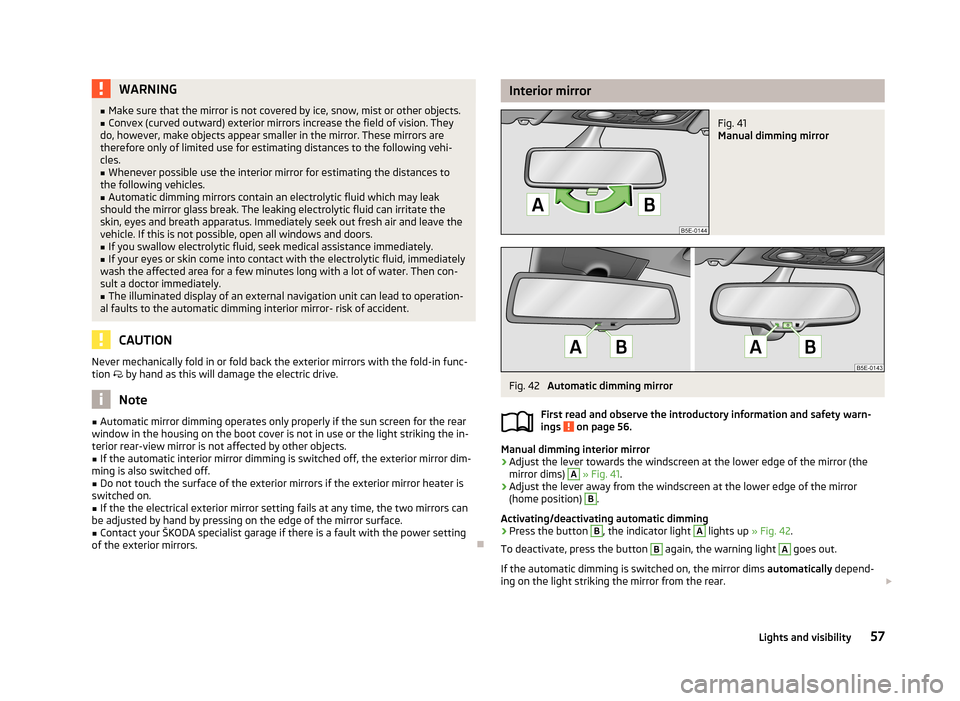
WARNINGâ Make sure that the mirror is not covered by ice, snow, mist or other objects.â Convex (curved outward) exterior mirrors increase the field of vision. They
do, however, make objects appear smaller in the mirror. These mirrors are
therefore only of limited use for estimating distances to the following vehi-
cles.â
Whenever possible use the interior mirror for estimating the distances to
the following vehicles.
â
Automatic dimming mirrors contain an electrolytic fluid which may leak
should the mirror glass break. The leaking electrolytic fluid can irritate the skin, eyes and breath apparatus. Immediately seek out fresh air and leave thevehicle. If this is not possible, open all windows and doors.
â
If you swallow electrolytic fluid, seek medical assistance immediately.
â
If your eyes or skin come into contact with the electrolytic fluid, immediately
wash the affected area for a few minutes long with a lot of water. Then con-
sult a doctor immediately.
â
The illuminated display of an external navigation unit can lead to operation-
al faults to the automatic dimming interior mirror- risk of accident.
CAUTION
Never mechanically fold in or fold back the exterior mirrors with the fold-in func-
tion ï« by hand as this will damage the electric drive.
Note
â
Automatic mirror dimming operates only properly if the sun screen for the rear
window in the housing on the boot cover is not in use or the light striking the in- terior rear-view mirror is not affected by other objects.â
If the automatic interior mirror dimming is switched off, the exterior mirror dim-
ming is also switched off.
â
Do not touch the surface of the exterior mirrors if the exterior mirror heater is
switched on.
â
If the the electrical exterior mirror setting fails at any time, the two mirrors can
be adjusted by hand by pressing on the edge of the mirror surface.
â
Contact your Ć KODA specialist garage if there is a fault with the power setting
of the exterior mirrors.
ï
Interior mirrorFig. 41
Manual dimming mirror
Fig. 42
Automatic dimming mirror
First read and observe the introductory information and safety warn-
ings
on page 56.
Manual dimming interior mirror
âș
Adjust the lever towards the windscreen at the lower edge of the mirror (the mirror dims)
A
» Fig. 41 .
âș
Adjust the lever away from the windscreen at the lower edge of the mirror
(home position)
B
.
Activating/deactivating automatic dimming
âș
Press the button
B
, the indicator light
A
lights up » Fig. 42.
To deactivate, press the button
B
again, the warning light
A
goes out.
If the automatic dimming is switched on, the mirror dims automatically depend-
ing on the light striking the mirror from the rear. ïŁ
ï€57Lights and visibility
Page 66 of 222
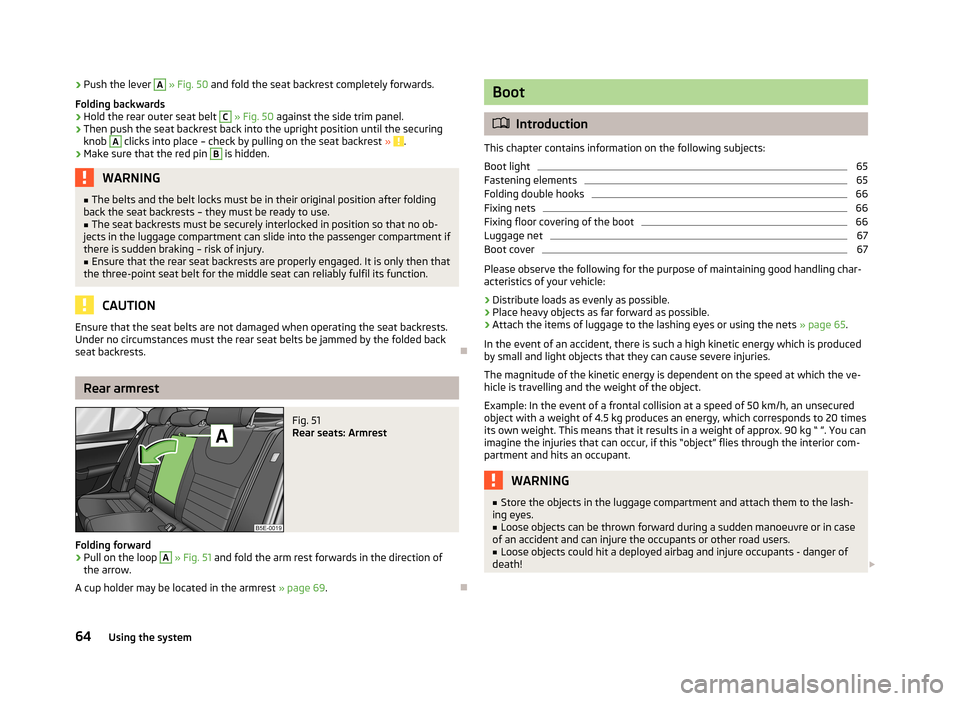
âșPush the lever A
» Fig. 50 and fold the seat backrest completely forwards.
Folding backwardsâș
Hold the rear outer seat belt
C
» Fig. 50 against the side trim panel.
âș
Then push the seat backrest back into the upright position until the securing
knob
A
clicks into place â check by pulling on the seat backrest » .
âș
Make sure that the red pin
B
is hidden.
WARNINGâ
The belts and the belt locks must be in their original position after folding
back the seat backrests â they must be ready to use.â
The seat backrests must be securely interlocked in position so that no ob-
jects in the luggage compartment can slide into the passenger compartment if
there is sudden braking â risk of injury.
â
Ensure that the rear seat backrests are properly engaged. It is only then that
the three-point seat belt for the middle seat can reliably fulfil its function.
CAUTION
Ensure that the seat belts are not damaged when operating the seat backrests. Under no circumstances must the rear seat belts be jammed by the folded back
seat backrests.ï
Rear armrest
Fig. 51
Rear seats: Armrest
Folding forward
âș
Pull on the loop
A
» Fig. 51 and fold the arm rest forwards in the direction of
the arrow.
A cup holder may be located in the armrest » page 69.
ï
Boot
ï€Introduction
This chapter contains information on the following subjects:
Boot light
65
Fastening elements
65
Folding double hooks
66
Fixing nets
66
Fixing floor covering of the boot
66
Luggage net
67
Boot cover
67
Please observe the following for the purpose of maintaining good handling char-
acteristics of your vehicle:
âș
Distribute loads as evenly as possible.
âș
Place heavy objects as far forward as possible.
âș
Attach the items of luggage to the lashing eyes or using the nets » page 65.
In the event of an accident, there is such a high kinetic energy which is produced
by small and light objects that they can cause severe injuries.
The magnitude of the kinetic energy is dependent on the speed at which the ve-
hicle is travelling and the weight of the object.
Example: In the event of a frontal collision at a speed of 50 km/h, an unsecured
object with a weight of 4.5 kg produces an energy, which corresponds to 20 times
its own weight. This means that it results in a weight of approx. 90 kg â â. You can imagine the injuries that can occur, if this âobjectâ flies through the interior com-partment and hits an occupant.
WARNINGâ Store the objects in the luggage compartment and attach them to the lash-
ing eyes.â
Loose objects can be thrown forward during a sudden manoeuvre or in case
of an accident and can injure the occupants or other road users.
â
Loose objects could hit a deployed airbag and injure occupants - danger of
death! ïŁ
64Using the system
Page 67 of 222
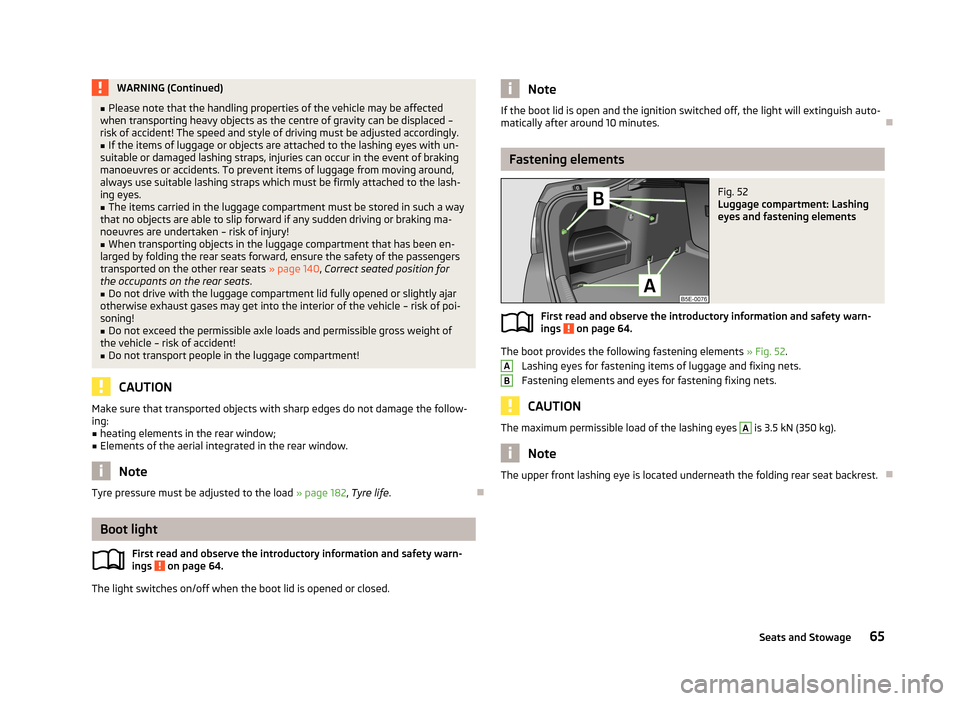
WARNING (Continued)â Please note that the handling properties of the vehicle may be affected
when transporting heavy objects as the centre of gravity can be displaced â
risk of accident! The speed and style of driving must be adjusted accordingly.â
If the items of luggage or objects are attached to the lashing eyes with un-
suitable or damaged lashing straps, injuries can occur in the event of braking manoeuvres or accidents. To prevent items of luggage from moving around,
always use suitable lashing straps which must be firmly attached to the lash-
ing eyes.
â
The items carried in the luggage compartment must be stored in such a way
that no objects are able to slip forward if any sudden driving or braking ma-
noeuvres are undertaken â risk of injury!
â
When transporting objects in the luggage compartment that has been en-
larged by folding the rear seats forward, ensure the safety of the passengers transported on the other rear seats » page 140, Correct seated position for
the occupants on the rear seats .
â
Do not drive with the luggage compartment lid fully opened or slightly ajar
otherwise exhaust gases may get into the interior of the vehicle â risk of poi-
soning!
â
Do not exceed the permissible axle loads and permissible gross weight of
the vehicle â risk of accident!
â
Do not transport people in the luggage compartment!
CAUTION
Make sure that transported objects with sharp edges do not damage the follow-
ing:â
heating elements in the rear window;
â
Elements of the aerial integrated in the rear window.
Note
Tyre pressure must be adjusted to the load » page 182
, Tyre life .ï
Boot light
First read and observe the introductory information and safety warn-
ings
on page 64.
The light switches on/off when the boot lid is opened or closed.
ï€NoteIf the boot lid is open and the ignition switched off, the light will extinguish auto-
matically after around 10 minutes.ï
Fastening elements
Fig. 52
Luggage compartment: Lashing
eyes and fastening elements
First read and observe the introductory information and safety warn- ings on page 64.
The boot provides the following fastening elements » Fig. 52.
Lashing eyes for fastening items of luggage and fixing nets.
Fastening elements and eyes for fastening fixing nets.
CAUTION
The maximum permissible load of the lashing eyes A is 3.5 kN (350 kg).
Note
The upper front lashing eye is located underneath the folding rear seat backrest.ï
ï€AB65Seats and Stowage
Page 68 of 222
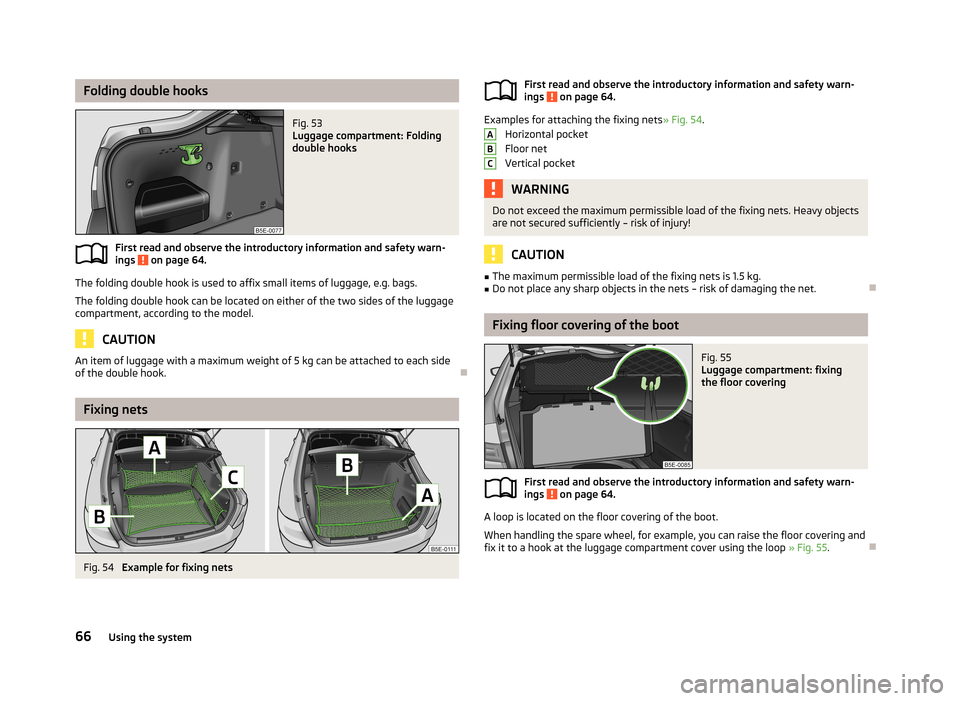
Folding double hooksFig. 53
Luggage compartment: Folding
double hooks
First read and observe the introductory information and safety warn-
ings on page 64.
The folding double hook is used to affix small items of luggage, e.g. bags.
The folding double hook can be located on either of the two sides of the luggage
compartment, according to the model.
CAUTION
An item of luggage with a maximum weight of 5 kg can be attached to each side
of the double hook.ï
Fixing nets
Fig. 54
Example for fixing nets
ï€First read and observe the introductory information and safety warn- ings on page 64.
Examples for attaching the fixing nets » Fig. 54.
Horizontal pocket
Floor net
Vertical pocket
WARNINGDo not exceed the maximum permissible load of the fixing nets. Heavy objects are not secured sufficiently â risk of injury!
CAUTION
â The maximum permissible load of the fixing nets is 1.5 kg.â Do not place any sharp objects in the nets â risk of damaging the net.
ï
Fixing floor covering of the boot
Fig. 55
Luggage compartment: fixing
the floor covering
First read and observe the introductory information and safety warn- ings on page 64.
A loop is located on the floor covering of the boot.
When handling the spare wheel, for example, you can raise the floor covering andfix it to a hook at the luggage compartment cover using the loop » Fig. 55.
ï
ï€ABCï€66Using the system
Page 69 of 222
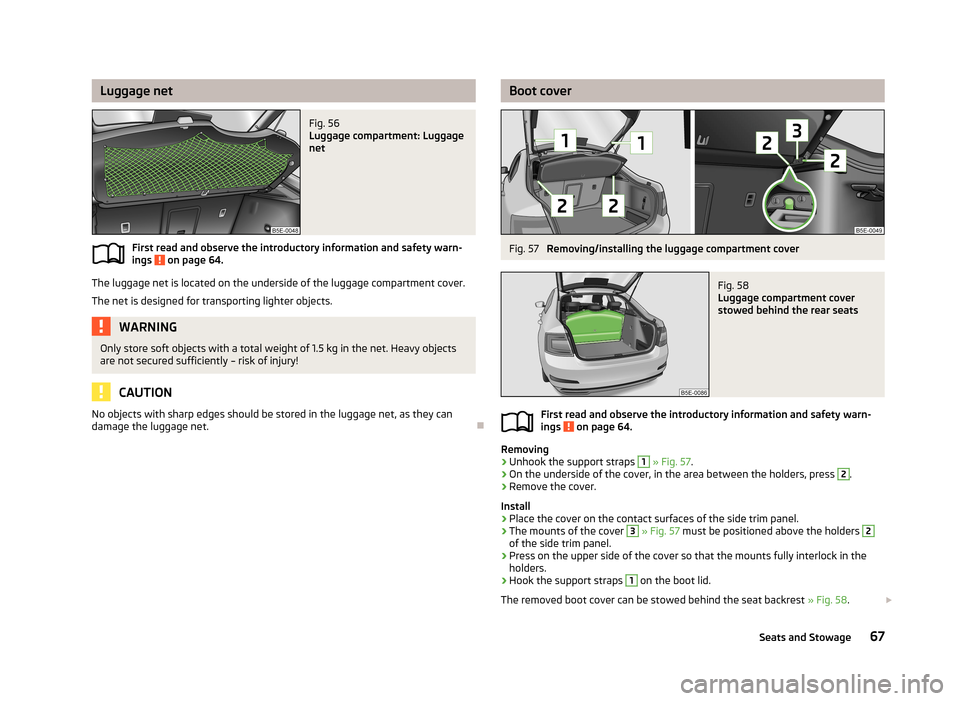
Luggage netFig. 56
Luggage compartment: Luggage
net
First read and observe the introductory information and safety warn-
ings on page 64.
The luggage net is located on the underside of the luggage compartment cover.
The net is designed for transporting lighter objects.
WARNINGOnly store soft objects with a total weight of 1.5 kg in the net. Heavy objects
are not secured sufficiently â risk of injury!
CAUTION
No objects with sharp edges should be stored in the luggage net, as they can
damage the luggage net.ï
ï€Boot coverFig. 57
Removing/installing the luggage compartment cover
Fig. 58
Luggage compartment cover
stowed behind the rear seats
First read and observe the introductory information and safety warn-
ings on page 64.
Removing
âș
Unhook the support straps
1
» Fig. 57 .
âș
On the underside of the cover, in the area between the holders, press
2
.
âș
Remove the cover.
Install
âș
Place the cover on the contact surfaces of the side trim panel.
âș
The mounts of the cover
3
» Fig. 57 must be positioned above the holders
2
of the side trim panel.
âș
Press on the upper side of the cover so that the mounts fully interlock in the
holders.
âș
Hook the support straps
1
on the boot lid.
The removed boot cover can be stowed behind the seat backrest » Fig. 58.ïŁ
ï€67Seats and Stowage
Page 70 of 222
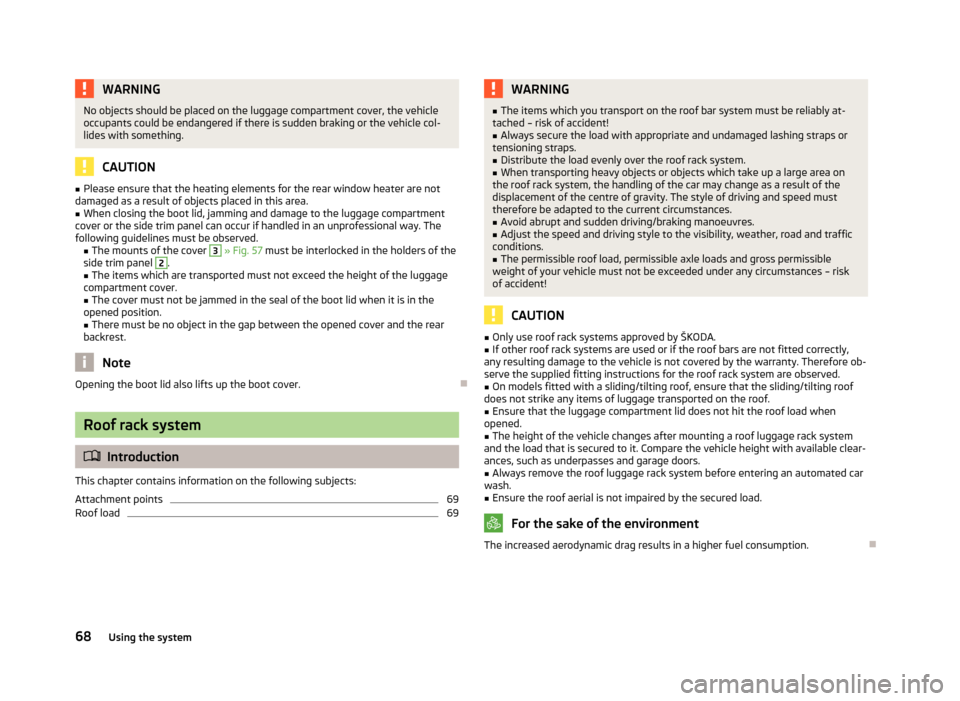
WARNINGNo objects should be placed on the luggage compartment cover, the vehicle
occupants could be endangered if there is sudden braking or the vehicle col-
lides with something.
CAUTION
â Please ensure that the heating elements for the rear window heater are not
damaged as a result of objects placed in this area.â
When closing the boot lid, jamming and damage to the luggage compartment
cover or the side trim panel can occur if handled in an unprofessional way. The following guidelines must be observed. â The mounts of the cover
3
» Fig. 57 must be interlocked in the holders of the
side trim panel
2
.
â The items which are transported must not exceed the height of the luggage
compartment cover. â The cover must not be jammed in the seal of the boot lid when it is in the
opened position.
â There must be no object in the gap between the opened cover and the rear
backrest.
Note
Opening the boot lid also lifts up the boot cover.ï
Roof rack system
ï€ Introduction
This chapter contains information on the following subjects:
Attachment points
69
Roof load
69WARNINGâ The items which you transport on the roof bar system must be reliably at-
tached â risk of accident!â
Always secure the load with appropriate and undamaged lashing straps or
tensioning straps.
â
Distribute the load evenly over the roof rack system.
â
When transporting heavy objects or objects which take up a large area on
the roof rack system, the handling of the car may change as a result of the displacement of the centre of gravity. The style of driving and speed musttherefore be adapted to the current circumstances.
â
Avoid abrupt and sudden driving/braking manoeuvres.
â
Adjust the speed and driving style to the visibility, weather, road and traffic
conditions.
â
The permissible roof load, permissible axle loads and gross permissible
weight of your vehicle must not be exceeded under any circumstances â risk
of accident!
CAUTION
â Only use roof rack systems approved by Ć KODA.â If other roof rack systems are used or if the roof bars are not fitted correctly,
any resulting damage to the vehicle is not covered by the warranty. Therefore ob-
serve the supplied fitting instructions for the roof rack system are observed.â
On models fitted with a sliding/tilting roof, ensure that the sliding/tilting roof
does not strike any items of luggage transported on the roof.
â
Ensure that the luggage compartment lid does not hit the roof load when
opened.
â
The height of the vehicle changes after mounting a roof luggage rack system
and the load that is secured to it. Compare the vehicle height with available clear-
ances, such as underpasses and garage doors.
â
Always remove the roof luggage rack system before entering an automated car
wash.
â
Ensure the roof aerial is not impaired by the secured load.
For the sake of the environment
The increased aerodynamic drag results in a higher fuel consumption.ï
68Using the system
Page 73 of 222
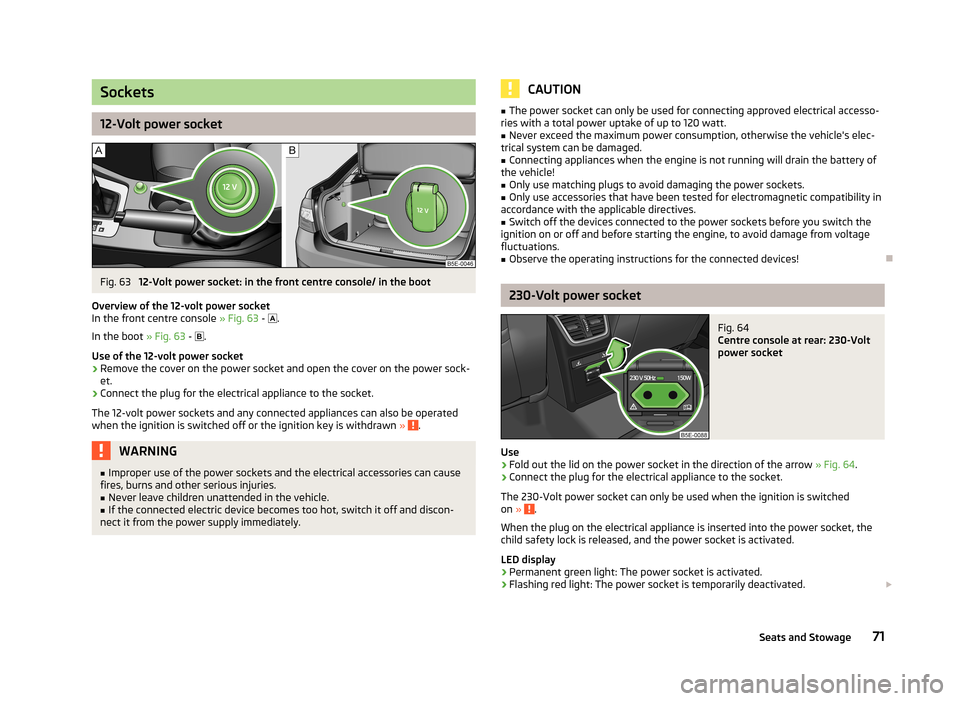
Sockets
12-Volt power socket
Fig. 63
12-Volt power socket: in the front centre console/ in the boot
Overview of the 12-volt power socket
In the front centre console » Fig. 63 - ï
.
In the boot » Fig. 63 - ï
.
Use of the 12-volt power socket
âș
Remove the cover on the power socket and open the cover on the power sock-
et.
âș
Connect the plug for the electrical appliance to the socket.
The 12-volt power sockets and any connected appliances can also be operated when the ignition is switched off or the ignition key is withdrawn »
.
WARNINGâ
Improper use of the power sockets and the electrical accessories can cause
fires, burns and other serious injuries.â
Never leave children unattended in the vehicle.
â
If the connected electric device becomes too hot, switch it off and discon-
nect it from the power supply immediately.
CAUTIONâ The power socket can only be used for connecting approved electrical accesso-
ries with a total power uptake of up to 120 watt.â
Never exceed the maximum power consumption, otherwise the vehicle's elec-
trical system can be damaged.
â
Connecting appliances when the engine is not running will drain the battery of
the vehicle!
â
Only use matching plugs to avoid damaging the power sockets.
â
Only use accessories that have been tested for electromagnetic compatibility in
accordance with the applicable directives.
â
Switch off the devices connected to the power sockets before you switch the
ignition on or off and before starting the engine, to avoid damage from voltage
fluctuations.
â
Observe the operating instructions for the connected devices!
ï
230-Volt power socket
Fig. 64
Centre console at rear: 230-Volt
power socket
Use
âș
Fold out the lid on the power socket in the direction of the arrow » Fig. 64
.
âș
Connect the plug for the electrical appliance to the socket.
The 230-Volt power socket can only be used when the ignition is switched on »
.
When the plug on the electrical appliance is inserted into the power socket, the
child safety lock is released, and the power socket is activated.
LED display âș Permanent green light: The power socket is activated.
âș Flashing red light: The power socket is temporarily deactivated.
ïŁ
71Seats and Stowage
Page 74 of 222
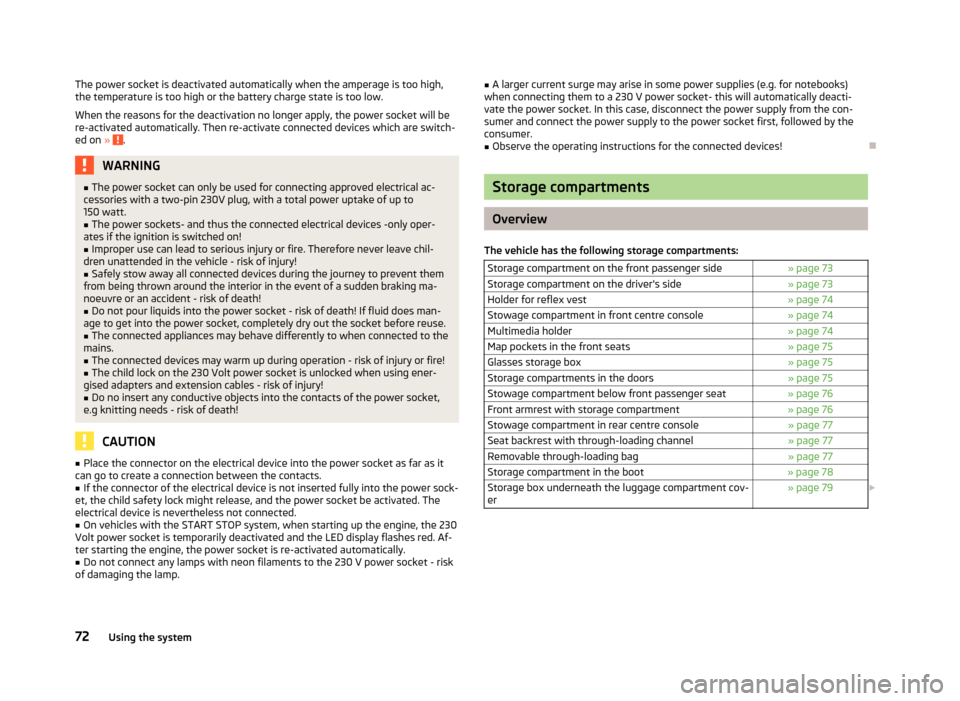
The power socket is deactivated automatically when the amperage is too high,
the temperature is too high or the battery charge state is too low.
When the reasons for the deactivation no longer apply, the power socket will be
re-activated automatically. Then re-activate connected devices which are switch- ed on »
.
WARNINGâ
The power socket can only be used for connecting approved electrical ac-
cessories with a two-pin 230V plug, with a total power uptake of up to
150 watt.â
The power sockets- and thus the connected electrical devices -only oper-
ates if the ignition is switched on!
â
Improper use can lead to serious injury or fire. Therefore never leave chil-
dren unattended in the vehicle - risk of injury!
â
Safely stow away all connected devices during the journey to prevent them
from being thrown around the interior in the event of a sudden braking ma- noeuvre or an accident - risk of death!
â
Do not pour liquids into the power socket - risk of death! If fluid does man-
age to get into the power socket, completely dry out the socket before reuse.
â
The connected appliances may behave differently to when connected to the
mains.
â
The connected devices may warm up during operation - risk of injury or fire!
â
The child lock on the 230 Volt power socket is unlocked when using ener-
gised adapters and extension cables - risk of injury!
â
Do no insert any conductive objects into the contacts of the power socket,
e.g knitting needs - risk of death!
CAUTION
â Place the connector on the electrical device into the power socket as far as it
can go to create a connection between the contacts.â
If the connector of the electrical device is not inserted fully into the power sock-
et, the child safety lock might release, and the power socket be activated. The
electrical device is nevertheless not connected.
â
On vehicles with the START STOP system, when starting up the engine, the 230
Volt power socket is temporarily deactivated and the LED display flashes red. Af-
ter starting the engine, the power socket is re-activated automatically.
â
Do not connect any lamps with neon filaments to the 230 V power socket - risk
of damaging the lamp.
â A larger current surge may arise in some power supplies (e.g. for notebooks)
when connecting them to a 230 V power socket- this will automatically deacti-
vate the power socket. In this case, disconnect the power supply from the con-
sumer and connect the power supply to the power socket first, followed by the
consumer.â
Observe the operating instructions for the connected devices!
ï
Storage compartments
Overview
The vehicle has the following storage compartments:
Storage compartment on the front passenger side» page 73Storage compartment on the driver's side» page 73Holder for reflex vest» page 74Stowage compartment in front centre console» page 74Multimedia holder» page 74Map pockets in the front seats» page 75Glasses storage box» page 75Storage compartments in the doors» page 75Stowage compartment below front passenger seat» page 76Front armrest with storage compartment» page 76Stowage compartment in rear centre console» page 77Seat backrest with through-loading channel» page 77Removable through-loading bag» page 77Storage compartment in the boot» page 78Storage box underneath the luggage compartment cov-
er» page 79 ïŁ72Using the system